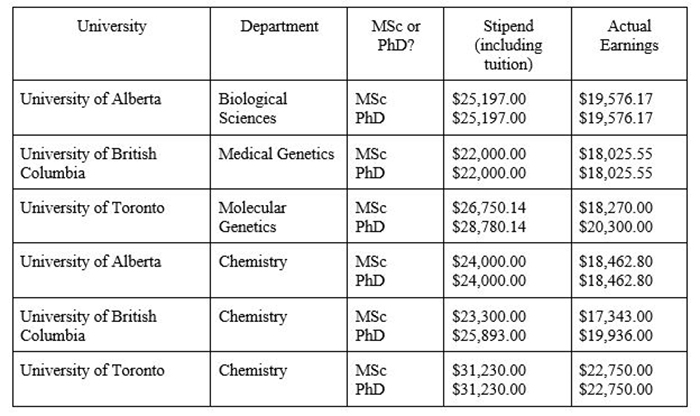Farah Qaiser and Nahomi Amberber, Policy and Politics co-editors
Graduate students play a key role in their scientific fields. Under the supervision of a trained scientist, these students learn how to propose novel ideas, carry out experiments to test their hypotheses, and contribute to the science community’s growing hub of knowledge. However, a day in graduate school is not your typical school day, as laboratory experiments may extend into the evening and weekends. This leaves little room for full, or even part-time, jobs to pay for basic living expenses, to say nothing of tuition and student fees. So, how do the thousands of students pursuing this path pay their way through graduate school? And where is the money coming from?
In this post, we explore the three main sources of income that graduate students typically receive: stipends, grants and awards, and teaching assistant (TA)-ships. In order to pay their expenses, graduate students must balance their costs and earnings carefully depending on the total of these sources. While this post generally follows funding models prevalent in our STEM fields of interest (Chemistry and Molecular Genetics), many aspects apply to all STEM graduate students.
Stipends are the largest source of income. They are generally granted to STEM graduate students pursuing a research-based MSc or PhD degree, but not to those completing a course-based or professional program (e.g., medicine or dentistry).
The source of the stipend varies from department to department. For example, in certain departments, graduate student stipends are a fixed salary given by the student’s faculty supervisor in recognition of the work being done, while in other departments, these stipends may be administered by the department as a salary, a TA-ship (discussed below) or a scholarship.
While minimum stipends vary across universities and fields, they take into account tuition and student fees (which are tax deductible), and leave behind a modest living allowance for basic expenses.
To create a snapshot of what these stipends look like, we gathered the minimum amounts Master’s (MSc) and Doctoral (PhD) students receive while completing a Molecular Genetics or Chemistry degree at three different universities across the country.
While only two specific STEM fields are considered, it’s easy to see that graduate stipends aren’t as straightforward as you might think. Even at the same university, the value of a stipend can vary drastically from department to department, and individual to individual (MSc versus PhD student, or domestic versus international student). And whereas science graduate students are typically guaranteed a stipend, graduate students in other fields, such as the humanities or professional programs, may receive little to no funding at all.
Another potential source of funding is internal or external grants/awards, which range from hundreds to thousands of dollars for a student. Government research agencies, such as the Canadian Institutes of Health Research (CIHR) and the National Sciences and Engineering Research Council (NSERC), fund external awards. They offer a number of awards and can review thousands of research proposals before choosing recipients. Graduate students can apply to a variety of external grants/awards, including the Canada Graduate Scholarships–Master’s Program ($17,500 allocated for 12 months), the Ontario Graduate Scholarship Program ($10,000 granted for two consecutive terms of study) or the highly esteemed Vanier Canada Graduate Scholarship ($50,000 per year to PhD students for three years).
Similarly, there are internal awards, funded byuniversity departments, that recognize financial need or merit. In Canada’s competitive research world, earning one of these internal or external awards is difficult, as the number of applicants may range from the hundreds to the thousands.
Depending on university or departmental regulations, this award or grant money can be used to pay the student’s annual stipend.This means a student might be less expensive for a supervisor to take on because an external award subsidizes the student’s stipend. For example, at the University of Toronto’s Faculty of Medicine, if a graduate student receives a small, internal award (up to $2,000), it will go directly to the graduate student, without having an impact on his or her stipend. Larger, external awards ($15,000 or more) will be used to pay the student’s stipend.
In some cases, graduate students are awarded a ‘top-up’ to recognize that they received an external competitive award. To go back to the University of Toronto example: if a graduate student receives an external award worth $15,000+, that money will go directly to his or her stipend, but the student will also receive an additional top-up of up to $4,000 from the university for his or her own use (for a total of $19,000+).
Another source of income is TA-ships, which are short-term contract positions that generally involve supporting undergraduate courses (teaching and grading). These positions pay for hours that are in addition to the ones graduate students spend working on their research project. Once again, TA-ships vary from school to school. In certain departments, students apply for these positions for an additional source of income. In other cases, graduate students may find that admission to their department is conditional on them serving as a TA if they have no other source of funding (e.g., grant or award).
Teaching-assistant wages vary by department. For example, at the University of Toronto, TAs are paid $43.65/hour + 4% vacation pay, while at Ryerson University, TAs are paid $42.97 or $46.41/hour + 4% vacation pay as a MSc and PhD student respectively. Similar to grants and awards, the amount of the student’s stipend that the department/supervisor pays may take into consideration whether or not the student is eligible for a TA-ship.
Of course, living in expensive, booming cities such as Vancouver and Toronto, or supporting any dependents, may mean that the total income generated from an annual stipend, awards, and TA-ships is not enough. For these students, part-time jobs within the university (such as being an exam invigilator), outside of the university (which are generally not recommended or endorsed by the department), paid internships (funded by the organization offering the placement, or through fellowships, such as Mitacs), and loans may be the only other available options.
Because a graduate degree can take anywhere from two to seven years to complete, knowing how you are going to support yourself financially beforehand is important. Graduate school is already a mentally stressful endeavour, so the last thing any graduate student wants on her mind is worry over how she’ll pay her bills. Be sure to carefully look into the income sources available to you, especially the fine print in your department’s stipends, available awards, and TA-ships, before you commit to graduate school.
~30~






